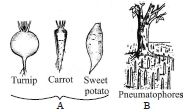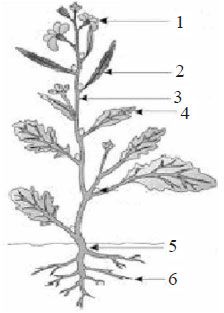Which part of plant is generally green when young and later often become woody and dark brown?
stem
seed
leaves
flower
Correct Answer :
A. stem
Stem is generally green when young and later often become woody and dark brown. The stem bears buds which may be terminal or axillary.
Related Questions
Cotyledons and testa respectively are edible parts in which of the following group?
walnut and tamarind
cashew nut and litchi
french bean and coconut
groundnut and pomegranate
Match the following placentation types given in column I with their examples given in column II and choose the correct combination from the options given below.
| (Placentation Types) | (Examples) |
|---|---|
| A. Basal | I. Dianthus |
| B. Free central | II. Pea |
| C. Parietal | III. Lemon |
| D. Axile | IV. Marigold |
| E. Marginal | V. Argemone |
A I, B II, C III, D IV, E V
A II, B III, C IV, D V, E I
A IV, B I, C V, D III, E II
A IV, B III, C V, D I, E II
Which one of the following statement is not correct?
Each stamen which represents the male reproductive organ consists of a stalk or a filament and an anther.
An actinomorphic flower can be dissected into two equal halves from any plane.
Superior ovary is found in hypogynous flowers.
When stamens are attached to the petals, they are epiphyllous as in brinjal.
Read the following statements and answer the question.
- It is the pattern of arrangement of leaves on the stem or branch.
- It is usually of three types - alternate, opposite and whorled.
- It is meant for getting maximum amount of light. statements?
Phyllotaxy
Venation
Inflorescencew
Aestivation
The root differs from stem in having
nodes and internodes
axillary buds
multicellular hairs
unicellular hairs
Seeds are regarded as products of sexual reproduction because they
can be stored for long time.
are result of fusion of pollen tube.
are result of fusion of gametes.
give rise to new plants.
Rearrange the following zones seen in the regions of root tip and choose the correct option.
(A) Root hair zone
(B) Zone of meristems
(C) Root cap zone
(D) Zone of maturation
(E) Zone of elongation
C, B, E, A, D
A, B, C, D, E
D, E, A, C, B
E, D, C, B, A
Which one of the following characteristics is not related to gynoecium?
It is the female reproductive part of the flower.
It is composed of stamens.
Stigma is usually at the tip of the style and is the receptive surface for pollen grains.
Each ovary bears one or more ovules attached to a flattened, cushion like placenta.
Identify the different types of aestivation (A, B, C and D) in corolla and select the correct option.

A-Valvate, B-Twisted, C-Imbricate, D-Vexillary
A-Vexillary, B-Valvate, C-Twisted, D-Imbricate
A-Imbricate, B-Vexillary, C-Valvate, D-Twisted
A-Twisted, B-Imbricate, C-Vexillary, D-Valvate
Match column - I, II and III and choose the correct option.

A - V, t; B - II, s; C -I, r; D -III, q; E -IV, p
A - I, t; B - II, s; C - III, r; D - IV, p; E - V, q
A - V, p; B - II, s; C - I, q; D - III, r; E - IV, t
A - V, p; B - III, q; C - II, s; D - I, t; E - IV, r
Match the column I with column II and choose the option which shows their correct match.
| Column I | Column II |
|---|---|
| A. Placentation | (i) Arrangement of flowers on the rachis |
| B. Aestivation | (ii) Modified shoot for sexual reproduction |
| C. Inflorescence | (iii) Arrangement of various whorls in the bud |
| D. Flower | (iv) Arrangement of ovules within an ovary |
A - (i), B - (ii), C - (iii), D - (iv)
A - (iii), B - (i), C - (ii), D - (iv)
A - (iii), B - (i), C - (iv), D - (ii)
A - (iv), B - (iii), C - (i), D - (ii)
The given figures (A and B) shows the modificaiton of roots.Which of the following statements regarding the figures is correct ?

Tap roots of carrot, turnip and adventitious root of sweet potato, get swollen and store food.
Pneumatophores conducts water, minerals & photosynthesis
Pneumatophore is found in the plants that grow in sandy soil.
Turnip & carrot shows adventitious roots and sweet potato shows tap root.
The given figures (A & B) show two types of compound leaves. Choose the option which identity the correct compound leaf and their example (c).

A - Pinnately compound leaf, C - Neem
A - Palmately compound leaf, C - Neem
B- Pinnately compound leaf, C - Silk cotton
B- Palmately compound leaf, C - Silk cotton
In which of the following plants, a slender lateral branch arises from the base of the main axis and after growing aerially arch downwards to touch the ground?
Mint and jasmine
Banana and pineapple
Grass and stawberry
Pistia and Eichhornia
Which one of the following statement is correct?
Bulb of Allium cepa is a modified stem.
Cloves of Allium sativum are fleshy scale leaves.
Corm of Colocasia is a modified root.
Tendril in Vitis vinifera is a modified axillary bud.
The given figure shows the parts of flowering plant. Which parts of the given figure were involved in the following functions:
- Storing reserve food material
- Synthesis of plant growth regulators.
- Absorption of water and minerals from the soil.
- Providing a proper anchorage to the plant parts

5 and 6
1, 2 and 6
1, 2, 3 and 4
2, 4, 5 and 6
When a flower has both androecium and gynoecium, it is known as__________.
asexual
bisexual
unisexual
multisexual
Statement 1 : A simple leaf has undivided lamina.
Statement 2 : Leaves showing pinnate and palmate venations have various type of incisions.
Statement-1 and statement-2 are true and statement-2 is a correct explanation for statement -1.
Statement -1 and statement -2 are true but statement-2 is not a correct explanation for statement-1.
Statement-1 is true and statement-2 is false.
Both the statements are false.
Root hairs develop from
region of maturation
region of elongation
region of meristematic activity
root cap
The main function(s) of root system is/are
absorption of water and minerals from the soil
storing reserve food material
synthesis of plant growth regulators
All of the above
Match column I with column II and choose the correct combination from the options given below.
| (Position of floral parts on thalamus) | (Represented in) |
|---|---|
| A. Hypogynous | I. Ray florets of sunflower |
| B. Perigynous | II. Brinjal |
| C Epigynous | III Peach |
A II, B I, C III
A I, B II, C III
A III, B II, C I
A II, B III, C I
A scar on the seed coat through which the developing seeds attached to the fruit is called as ________.
testa
tegmen
hilum
micropyle
Fibrous root system is found in
monocotyledonous plants.
dicotyledonous plants.
bryophytes.
gymnosperms.
Which of the following statements are correct?
- From the region of elongation, some of the epidermal cells form root hairs.
- Pneumatophores are seen in Rhizophora.
- Adventitious roots are seen in the banyan tree.
- Maize and sugarcane have prop roots.
(i) and (iv)
(i), (iii) and (iv)
(iii) and (iv)
(ii) and (iii)
Which of the following is an example of pinnately compound leaf ?
Cucumber
Papaya
Cucurbita
Neem
A sterile stamen is known as
staminode
anther
pollen grain
filament
Pollen grains are produced within _________of stamen.
ovary
anther
filament
connective
The region of the root-tip which is involved in the formation of root hairs by epidermal cells is called the
region of maturation.
region of meristematic activity.
region of elongation.
none of the above.
Identify the inflorescence shown by the given figures A and B.

A-Cymose, B-Racemose
A-Racemose, B-Cymose
A-Racemose, B-Racemose
A-Cymose, B-Cymose
A branch in which each node bearing a rossette of leaves and a tuft of roots is found in aquatic plants like _________ and _________.
Hydrilla and Pistia
Eichhornia and Hydrilla
Pistia and Eichhornia
Pistia and Vallisneria
